Pelvic Ring Fractures: A Biomechanical Comparison of Sacral and Lumbopelvic Fixation Techniques
Abstract
1. Introduction
2. Material and Methods
2.1. Finite Element Model of Lumbar Spine Pelvis
2.2. Simulation of Pelvic Ring Fracture
2.3. Simulating the Instrumentation of Pelvic Ring Fracture
- L5-Ilium posterior screw fixation without cross connectors (L5_PF_WO_CC): Bilateral posterior screw fixation was performed from L5-Ilium. The pedicle screws were connected to spinal rods.
- L5-Ilium posterior screw fixation with cross connectors (L5_PF_W_CC): Bilateral posterior screw fixation was performed from L5-Ilium. The pedicle screws were connected to spinal rods. A cross connector was placed at the S1 level to connect the two rods.
- TITS fixation at S1 and S2 level (S1_TITS_S2_TITS): TITS fixation was simulated at the S1 and S2 levels.
- IS fixation at S1 and TITS fixation at S2 level (S1_IS_S2_TITS): A TITS fixation was simulated at the S2 level, and an ilio-sacral screw (IS) fixation was performed at the S1 level.
- Double transiliac rod and screw fixation (DTSF): Two traditional iliac screws were placed bilaterally. A horizontal rod was used to connect the iliac screws.
2.4. Loading and Boundary Conditions
2.5. Data Analyses
3. Results
3.1. Stabilization at the Sacral Fracture Region (Figure 4 and Figure 5)
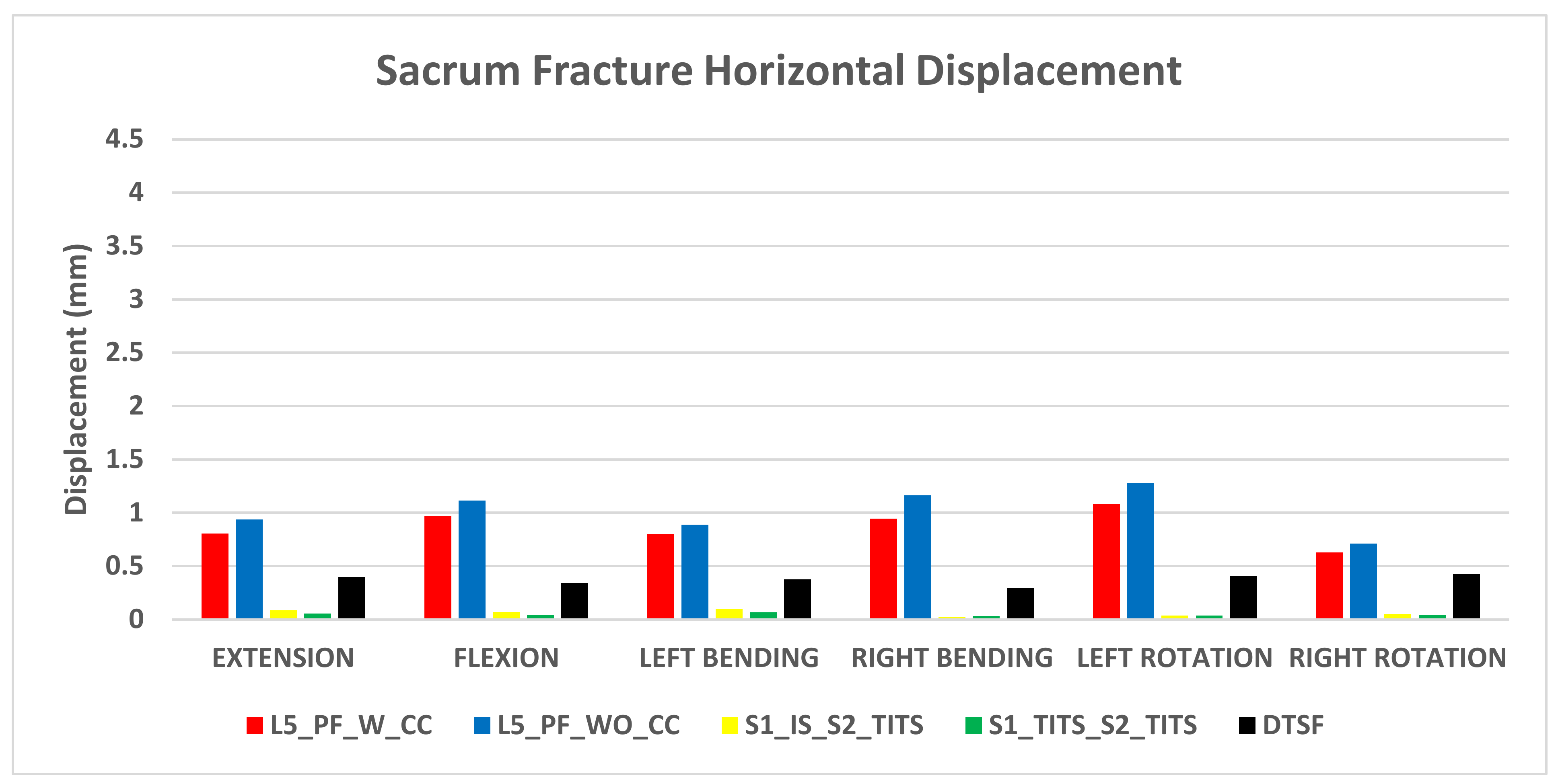
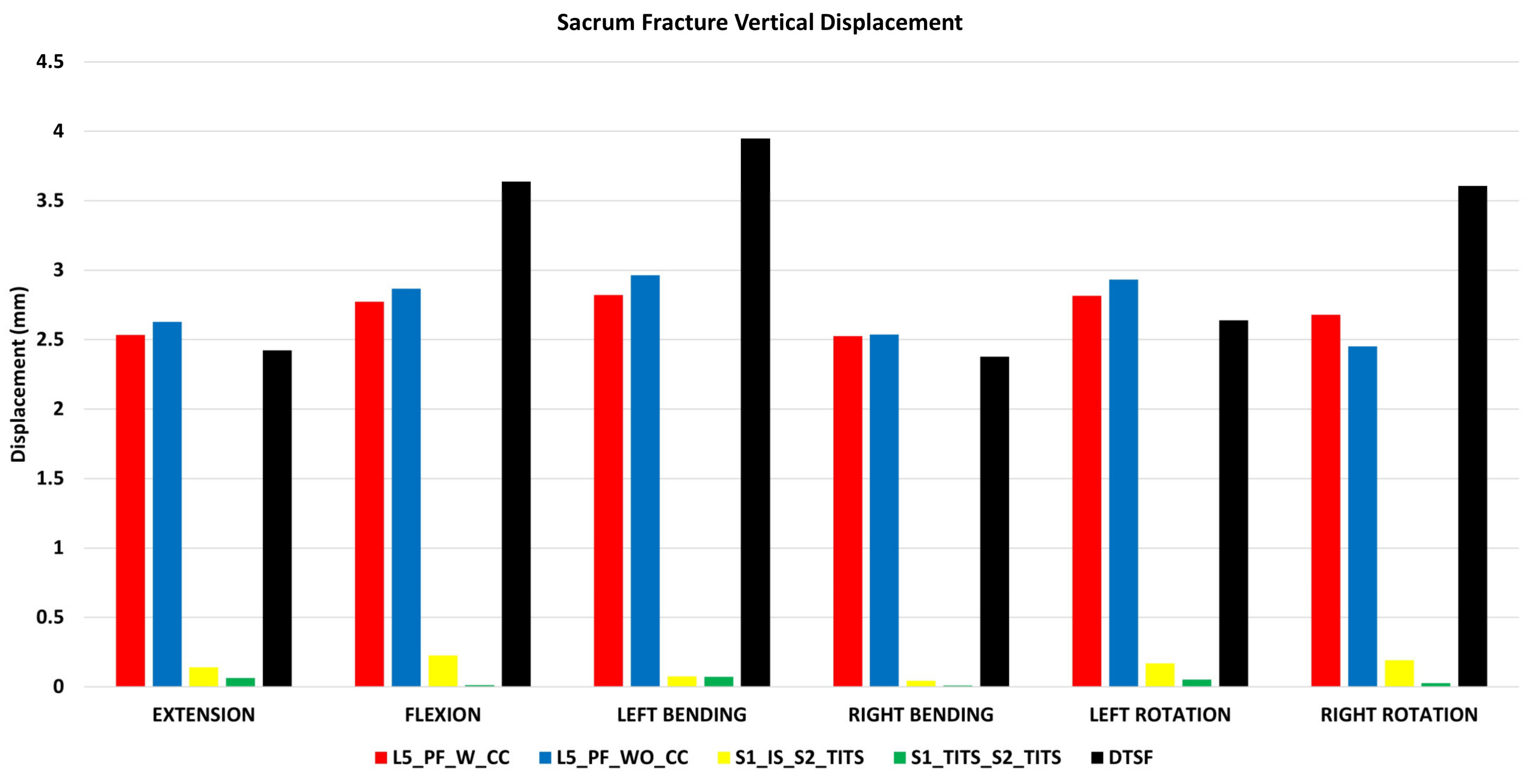
3.2. Stabilization at the Pubic Rami Fracture Region (Figure 6 and Figure 7)
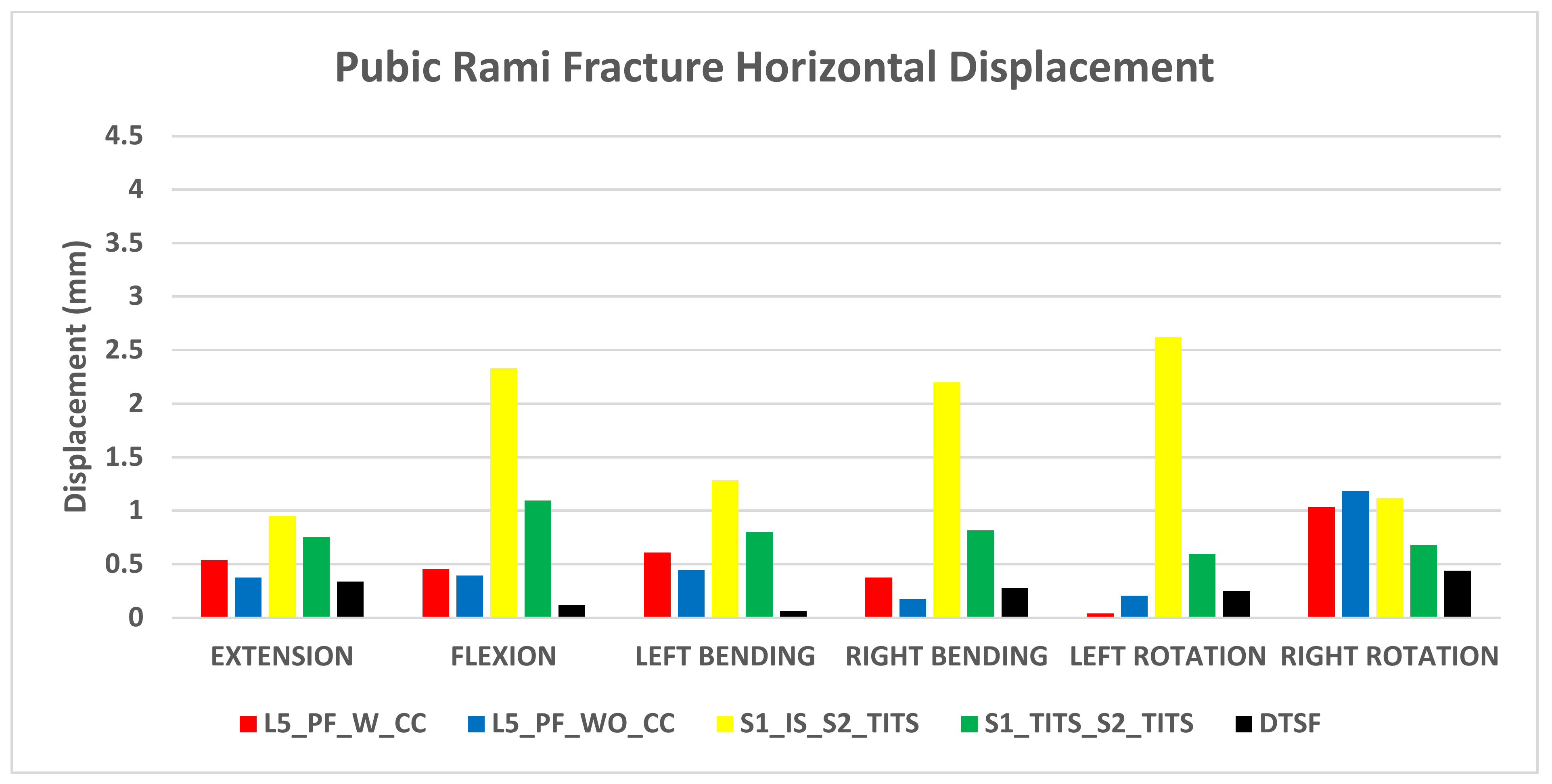
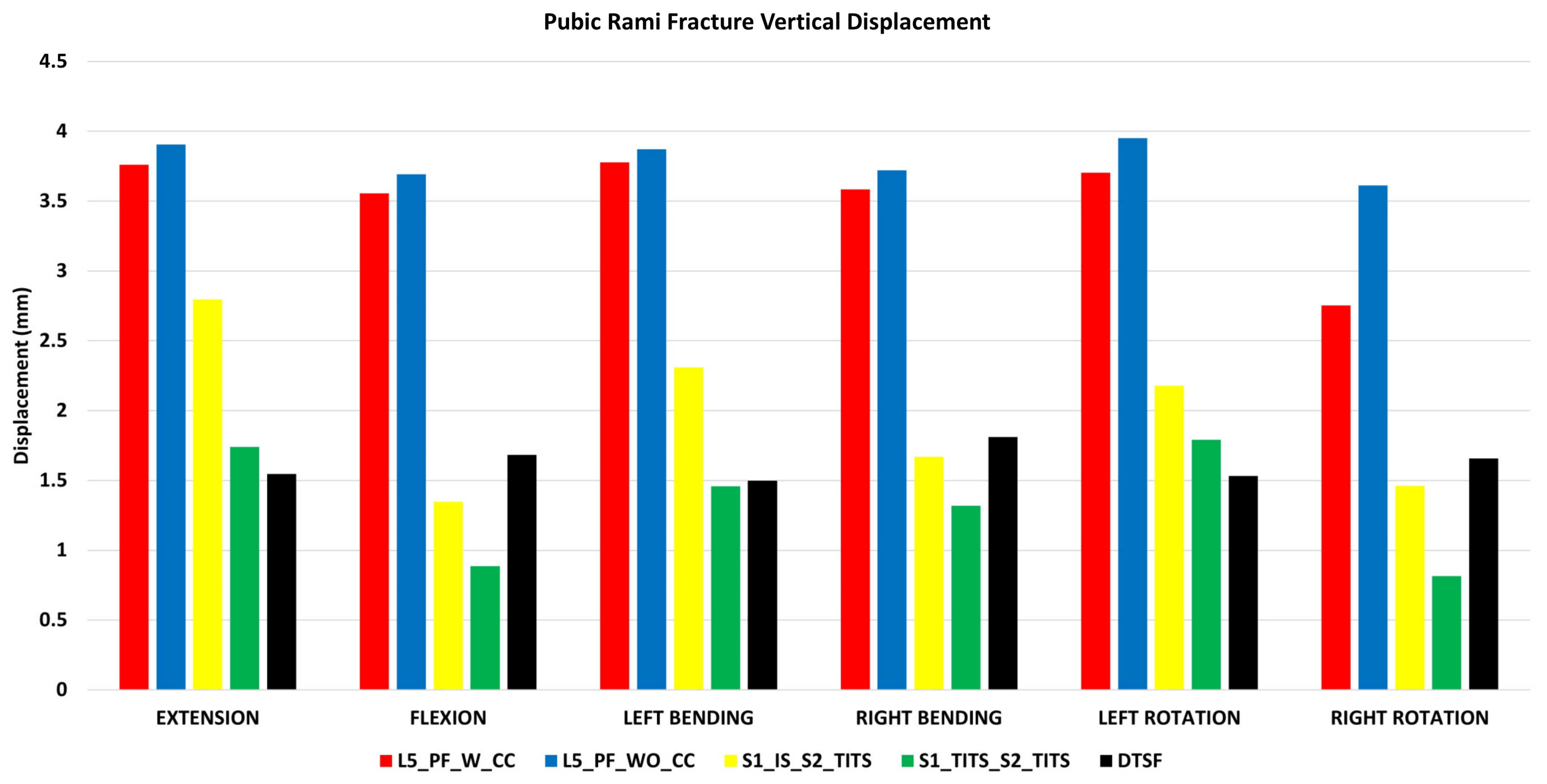
3.3. Sacroiliac Joint (SIJ) Range of Motion (ROM) (Figure 8)
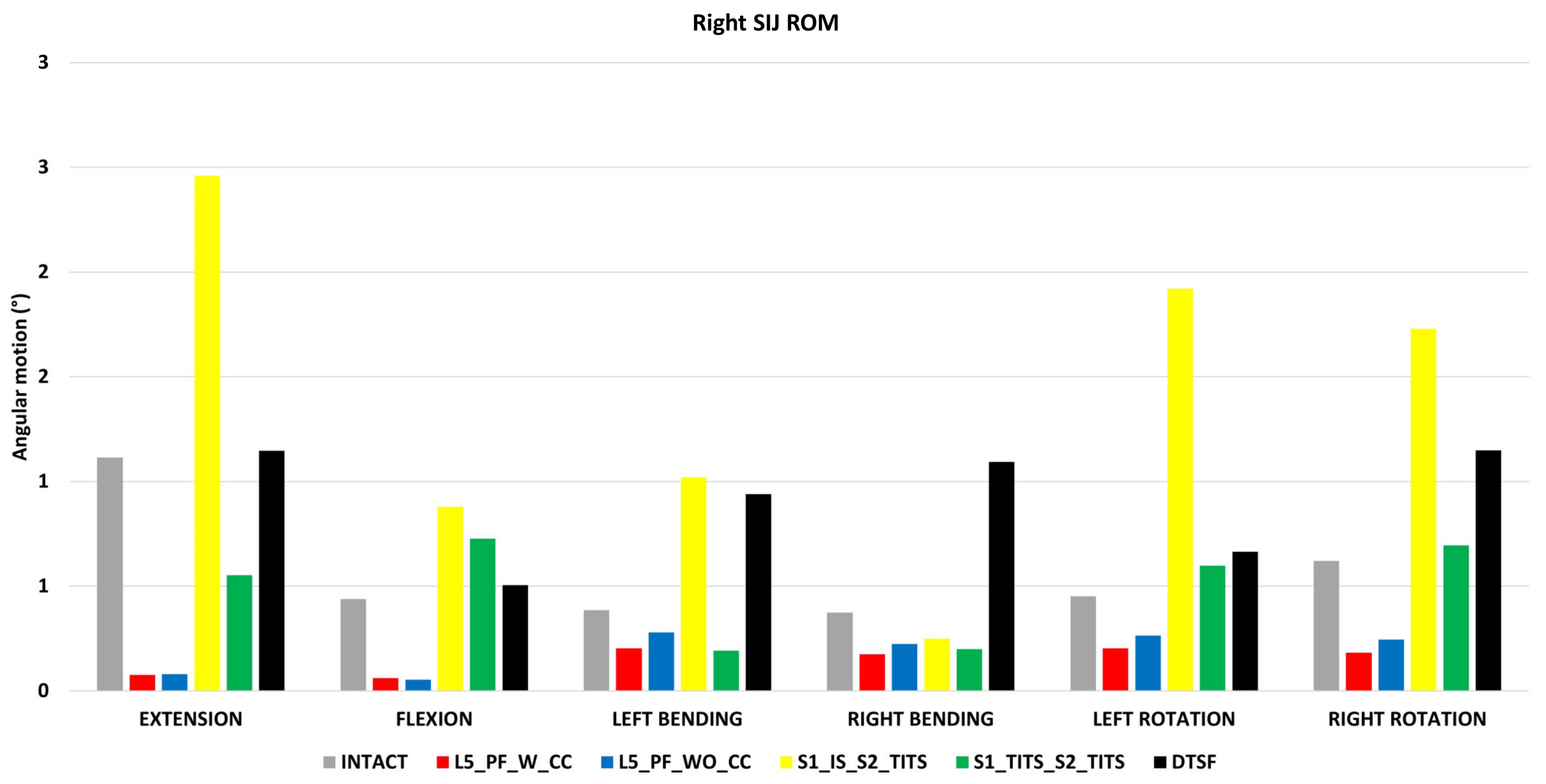
3.4. ROM at the L5-S1 Level (Figure 9)

3.5. Overall ROM for L1-S1 (Figure 10)
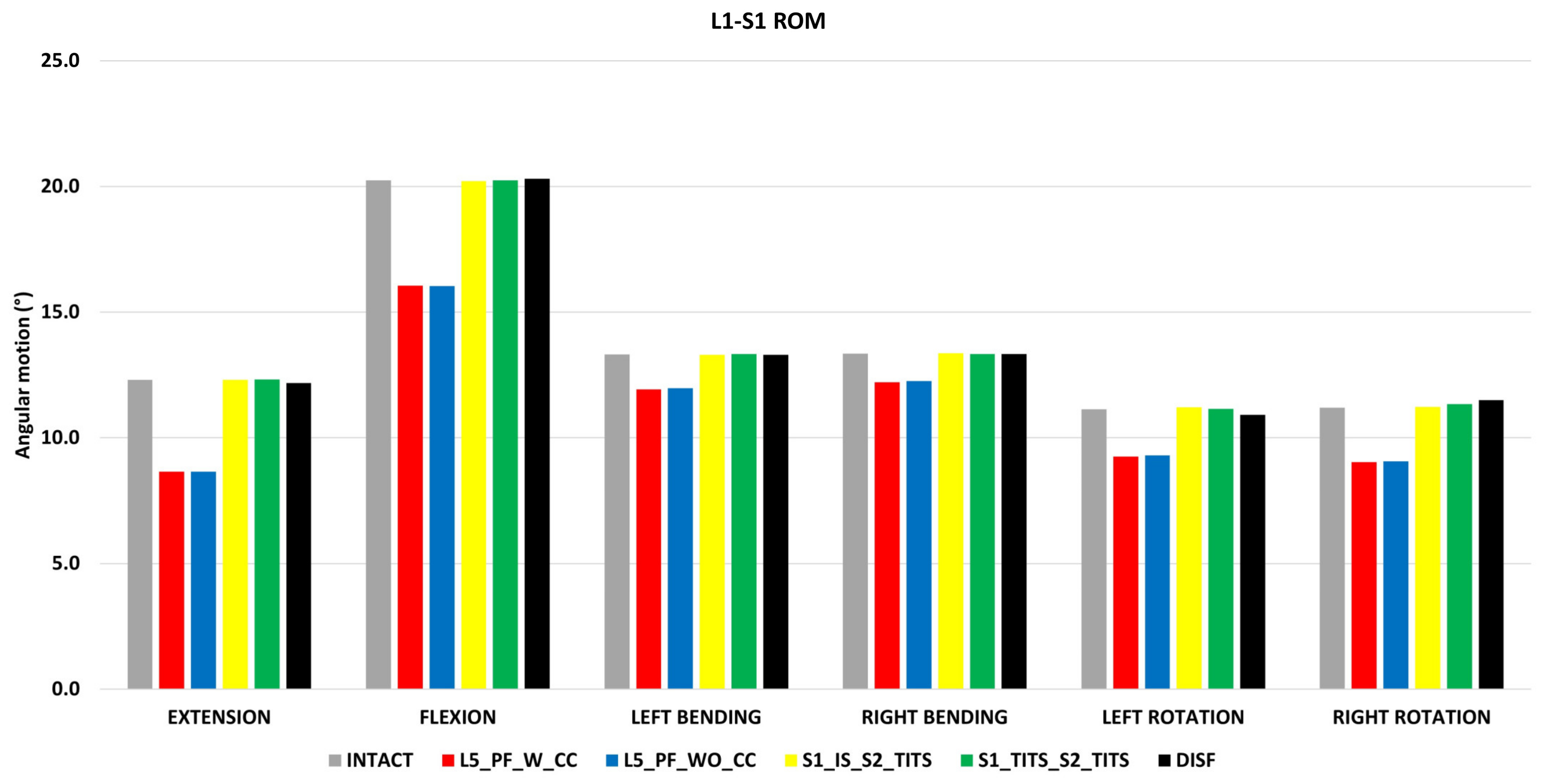
3.6. Peak von Mises Stresses at the L5-S1 Intervertebral Disc (Figure 11)

3.7. Stress on the Implants (Table 2)
| Von Mises Stress (MPa) | ||||||
|---|---|---|---|---|---|---|
| Extension | Flexion | Left Bending | Right Bending | Left Rotation | Right Rotation | |
| L5_PF_W_CC | 310.2 | 251.7 | 368.8 | 209 | 279.3 | 266.8 |
| Left Rod | Left Rod | Left Rod | Left Rod | Left Rod | Left Rod | |
| Between L5 & ilium Tulip | Between L5 & ilium Tulip | Between L5 & ilium Tulip | Between L5 & ilium Tulip | Between L5 & ilium Tulip | Between L5 & ilium Tulip | |
| L5_PF_WO_CC | 308.2 | 287.9 | 403 | 212.4 | 307.6 | 307.3 |
| Left Rod | Left Rod | Left Rod | Left Rod | Left Rod | Left Rod | |
| Between L5 & ilium Tulip | Between L5 & ilium Tulip | Between L5 & ilium Tulip | Between L5 & ilium Tulip | Between L5 & ilium Tulip | Between L5 & ilium Tulip | |
| S1_IS_S2_TITS | 114.2 | 132.1 | 155.3 | 86.17 | 154.8 | 168.2 |
| TITS | TITS | TITS | TITS | TITS | TITS | |
| S1_TITS_S2_TITS | 194 | 188.9 | 243.6 | 200.3 | 188.1 | 218.2 |
| Top TITS | Top TITS | Top TITS | Top TITS | Top TITS | Top TITS | |
| DTSF | 75.76 | 81.97 | 71.3 | 114.4 | 94.15 | 99.15 |
| Top Rod | Top Rod | Top Rod | Top Rod | Top Rod | Top Rod | |
4. Discussion
Limitations
5. Conclusions
Author Contributions
Funding
Institutional Review Board Statement
Informed Consent Statement
Data Availability Statement
Conflicts of Interest
Abbreviations
References
- Davis, D.D.; Foris, L.A.; Kane, S.M.; Waseem, M. Pelvic Fracture. In StatPearls; StatPearls Publishing LLC: Treasure Island, FL, USA, 2021. [Google Scholar]
- Rommens, P.M.; Hofmann, A. Comprehensive classification of fragility fractures of the pelvic ring: Recommendations for surgical treatment. Injury 2013, 44, 1733–1744. [Google Scholar] [CrossRef] [PubMed]
- Grotz, M.R.; Allami, M.K.; Harwood, P.; Pape, H.C.; Krettek, C.; Giannoudis, P.V. Open pelvic fractures: Epidemiology, current concepts of management and outcome. Injury 2005, 36, 1–13. [Google Scholar] [CrossRef]
- Isler, B.; Ganz, R. Classification of pelvic ring injuries. Injury 1996, 27 (Suppl. 1), 3–12. [Google Scholar] [CrossRef]
- Simonian, P.T.; Routt, M.L., Jr.; Harrington, R.M.; Tencer, A.F. Internal fixation of the unstable anterior pelvic ring: A biomechanical comparison of standard plating techniques and the retrograde medullary superior pubic ramus screw. J. Orthop. Trauma 1994, 8, 476–482. [Google Scholar] [CrossRef]
- Elzohairy, M.M.; Salama, A.M. Open reduction internal fixation versus percutaneous iliosacral screw fixation for unstable posterior pelvic ring disruptions. Orthop. Traumatol. Surg. Res. 2017, 103, 223–227. [Google Scholar] [CrossRef] [PubMed]
- Yinger, K.; Scalise, J.; Olson, S.A.; Bay, B.K.; Finkemeier, C.G. Biomechanical comparison of posterior pelvic ring fixation. J. Orthop. Trauma 2003, 17, 481–487. [Google Scholar] [CrossRef] [PubMed]
- Kerschbaum, M.; Hausmann, N.; Worlicek, M.; Pfeifer, C.; Nerlich, M.; Schmitz, P. Patient-related outcome of unstable pelvic ring fractures stabilized with a minimal invasive screw-rod system. Health Qual. Life Outcomes 2017, 15, 248. [Google Scholar] [CrossRef]
- Yuan, B.M.; Huang, G.; Zheng, S.; Yu, T.; Zhao, J.W. A screw view model of navigation guided minimal invasive percutaneous pelvic screws insertion for lateral compression pelvic ring injuries: A case report. Medicine 2020, 99, e21755. [Google Scholar] [CrossRef]
- Routt, M.L., Jr.; Kregor, P.J.; Simonian, P.T.; Mayo, K.A. Early results of percutaneous iliosacral screws placed with the patient in the supine position. J. Orthop. Trauma 1995, 9, 207–214. [Google Scholar] [CrossRef] [PubMed]
- Schweitzer, D.; Zylberberg, A.; Córdova, M.; Gonzalez, J. Closed reduction and iliosacral percutaneous fixation of unstable pelvic ring fractures. Injury 2008, 39, 869–874. [Google Scholar] [CrossRef] [PubMed]
- Wu, T.; Ren, X.; Cui, Y.; Cheng, X.; Peng, S.; Hou, Z.; Han, Y. Biomechanical study of three kinds of internal fixation for the treatment of sacroiliac joint disruption using biomechanical test and finite element analysis. J. Orthop. Surg. Res. 2018, 13, 152. [Google Scholar] [CrossRef] [PubMed]
- Toda, K.; Yagata, Y.; Kikuchi, T.; Takigawa, T.; Ito, Y. Minimally Invasive Surgery for Unstable Pelvic Ring Fractures: Transiliac Rod and Screw Fixation. Acta Med. Okayama 2020, 74, 27–32. [Google Scholar] [CrossRef] [PubMed]
- Allen, B.L., Jr.; Ferguson, R.L. The Galveston technique for L rod instrumentation of the scoliotic spine. Spine 1982, 7, 276–284. [Google Scholar] [CrossRef]
- Acklin, Y.P.; Zderic, I.; Richards, R.G.; Schmitz, P.; Gueorguiev, B.; Grechenig, S. Biomechanical investigation of four different fixation techniques in sacrum Denis type II fracture with low bone mineral density. J. Orthop. Res. 2018, 36, 1624–1629. [Google Scholar] [CrossRef] [PubMed]
- Hu, P.; Wu, T.; Wang, H.-Z.; Qi, X.-Z.; Yao, J.; Cheng, X.-D.; Chen, W.; Zhang, Y.-Z. Biomechanical Comparison of Three Internal Fixation Techniques for Stabilizing Posterior Pelvic Ring Disruption: A 3D Finite Element Analysis. Orthop. Surg. 2019, 11, 195–203. [Google Scholar] [CrossRef] [PubMed]
- Zhao, Y.; Zhang, S.; Sun, T.; Wang, D.; Lian, W.; Tan, J.; Zou, D.; Zhao, Y. Mechanical comparison between lengthened and short sacroiliac screws in sacral fracture fixation: A finite element analysis. Orthop. Traumatol. Surg. Res. 2013, 99, 601–606. [Google Scholar] [CrossRef] [PubMed]
- Schwab, F.; Ungar, B.; Blondel, B.; Buchowski, J.; Coe, J.; Deinlein, D.; DeWald, C.; Mehdian, H.; Shaffrey, C.; Tribus, C.; et al. Scoliosis Research Society-Schwab adult spinal deformity classification: A validation study. Spine 2012, 37, 1077–1082. [Google Scholar] [CrossRef]
- Kumaran, Y.; Nishida, N.; Tripathi, S.; Mumtaz, M.; Sakai, T.; Elgafy, H.; Goel, V.K. Effects of Sacral Slope Changes on the Intervertebral Disc and Hip Joint: A Finite Element Analysis. World Neurosurg. 2023, 176, e32–e39. [Google Scholar] [CrossRef]
- Nishida, N.; Mumtaz, M.; Tripathi, S.; Kumaran, Y.; Kelkar, A.; Sakai, T.; Goel, V.K. The Effect of Posterior Lumbar Interbody Fusion in Lumbar Spine Stenosis with Diffuse Idiopathic Skeletal Hyperostosis: A Finite Element Analysis. World Neurosurg. 2023, 176, e371–e379. [Google Scholar] [CrossRef] [PubMed]
- Goel, V.K.; Grauer, J.N.; Patel, T.; Biyani, A.; Sairyo, K.; Vishnubhotla, S.; Matyas, A.; Cowgill, I.; Shaw, M.; Long, R.; et al. Effects of charité artificial disc on the implanted and adjacent spinal segments mechanics using a hybrid testing protocol. Spine 2005, 30, 2755–2764. [Google Scholar] [CrossRef]
- Dalstra, M.; Huiskes, R.; van Erning, L. Development and validation of a three-dimensional finite element model of the pelvic bone. J. Biomech. Eng. 1995, 117, 272–278. [Google Scholar] [CrossRef] [PubMed]
- Momeni Shahraki, N.; Fatemi, A.; Goel, V.K.; Agarwal, A. On the Use of Biaxial Properties in Modeling Annulus as a Holzapfel-Gasser-Ogden Material. Front. Bioeng. Biotechnol. 2015, 3, 69. [Google Scholar] [CrossRef] [PubMed]
- Lindsey, D.P.; Kiapour, A.; Yerby, S.A.; Goel, V.K. Sacroiliac Joint Fusion Minimally Affects Adjacent Lumbar Segment Motion: A Finite Element Study. Int. J. Spine Surg. 2015, 9, 64. [Google Scholar] [CrossRef] [PubMed]
- Ivanov, A.A.; Kiapour, A.; Ebraheim, N.A.; Goel, V. Lumbar fusion leads to increases in angular motion and stress across sacroiliac joint: A finite element study. Spine 2009, 34, E162–E169. [Google Scholar] [CrossRef]
- Joukar, A.; Shah, A.; Kiapour, A.; Vosoughi, A.S.; Duhon, B.; Agarwal, A.K.; Elgafy, H.; Ebraheim, N.; Goel, V.K. Sex Specific Sacroiliac Joint Biomechanics during Standing Upright: A Finite Element Study. Spine 2018, 43, E1053–E1060. [Google Scholar] [CrossRef] [PubMed]
- Tripathi, S. Finite Element Analyses of Stabilization of Sacral Fractures (Zone I Denis Fracture) under One Leg Standing Stance; University of Toledo: Toledo, OH, USA, 2021. [Google Scholar]
- Nishida, N.; Mumtaz, M.; Tripathi, S.; Kelkar, A.; Kumaran, Y.; Sakai, T.; Goel, V.K. Biomechanical analysis of laminectomy, laminoplasty, posterior decompression with instrumented fusion, and anterior decompression with fusion for the kyphotic cervical spine. Int. J. Comput. Assist. Radiol. Surg. 2022, 17, 1531–1541. [Google Scholar] [CrossRef]
- Nishida, N.; Tripathi, S.; Mumtaz, M.; Kelkar, A.; Kumaran, Y.; Sakai, T.; Goel, V.K. Soft Tissue Injury in Cervical Spine Is a Risk Factor for Intersegmental Instability: A Finite Element Analysis. World Neurosurg. 2022, 164, e358–e366. [Google Scholar] [CrossRef] [PubMed]
- Guerado, E.; Cervan, A.M.; Cano, J.R.; Giannoudis, P.V. Spinopelvic injuries. Facts and controversies. Injury 2018, 49, 449–456. [Google Scholar] [CrossRef] [PubMed]
- Zhang, L.; Peng, Y.; Du, C.; Tang, P. Biomechanical study of four kinds of percutaneous screw fixation in two types of unilateral sacroiliac joint dislocation: A finite element analysis. Injury 2014, 45, 2055–2059. [Google Scholar] [CrossRef]
- Turbucz, M.; Pokorni, A.J.; Bigdon, S.F.; Hajnal, B.; Koch, K.; Szoverfi, Z.; Lazary, A.; Eltes, P.E. Patient-specific bone material modelling can improve the predicted biomechanical outcomes of sacral fracture fixation techniques: A comparative finite element study. Injury 2023, 54, 111162. [Google Scholar] [CrossRef]
- Engelmann, C. [Reconstructive surgery of the bronchi in inflammatory lesions]. Zentralbl. Chir. 1989, 114, 286–296. [Google Scholar] [PubMed]
- Bastian, J.D.; Bergmann, M.; Schwyn, R.; Keel, M.J.; Benneker, L.M. Assessment of the Breakaway Torque at the Posterior Pelvic Ring in Human Cadavers. J. Investig. Surg. 2015, 28, 328–333. [Google Scholar] [CrossRef][Green Version]
- Kim, C.H.; Kim, J.W. Plate versus sacroiliac screw fixation for treating posterior pelvic ring fracture: A Systematic review and meta-analysis. Injury 2020, 51, 2259–2266. [Google Scholar] [CrossRef] [PubMed]
- Kim, J.W.; Oh, C.W.; Oh, J.K.; Kyung, H.S.; Park, K.H.; Yoon, S.D.; Yoon, S.H. The incidence of and factors affecting iliosacral screw loosening in pelvic ring injury. Arch. Orthop. Trauma Surg. 2016, 136, 921–927. [Google Scholar] [CrossRef] [PubMed]
- Salazar, D.; Lannon, S.; Pasternak, O.; Schiff, A.; Lomasney, L.; Mitchell, E.; Stover, M. Investigation of bone quality of the first and second sacral segments amongst trauma patients: Concerns about iliosacral screw fixation. J. Orthop. Traumatol. 2015, 16, 301–308. [Google Scholar] [CrossRef] [PubMed]
- Moed, B.R.; Geer, B.L. S2 iliosacral screw fixation for disruptions of the posterior pelvic ring: A report of 49 cases. J. Orthop. Trauma 2006, 20, 378–383. [Google Scholar] [CrossRef] [PubMed]
- Griffin, D.R.; Starr, A.J.; Reinert, C.M.; Jones, A.L.; Whitlock, S. Vertically unstable pelvic fractures fixed with percutaneous iliosacral screws: Does posterior injury pattern predict fixation failure? J. Orthop. Trauma 2006, 20, S30–S36, discussion S6. [Google Scholar] [CrossRef] [PubMed]
- Eastman, J.G.; Shelton, T.J.; Routt, M.L.C., Jr.; Adams, M.R. Posterior pelvic ring bone density with implications for percutaneous screw fixation. Eur. J. Orthop. Surg. Traumatol. 2021, 31, 383–389. [Google Scholar] [CrossRef] [PubMed]
- Wu, C.C.; Jin, H.M.; Yan, Y.Z.; Chen, J.; Wang, K.; Wang, J.L.; Zhang, Z.J.; Wu, A.M.; Wang, X.Y. Biomechanical Role of the Thoracolumbar Ligaments of the Posterior Ligamentous Complex: A Finite Element Study. World Neurosurg. 2018, 112, e125–e133. [Google Scholar] [CrossRef]
- Rommens, P.M.; Arand, C.; Hofmann, A.; Wagner, D. When and How to Operate Fragility Fractures of the Pelvis? Indian. J. Orthop. 2019, 53, 128–137. [Google Scholar] [CrossRef]
- König, M.A.; Jehan, S.; Boszczyk, A.A.; Boszczyk, B.M. Surgical management of U-shaped sacral fractures: A systematic review of current treatment strategies. Eur. Spine J. 2012, 21, 829–836. [Google Scholar] [CrossRef] [PubMed]
- Chon, C.S.; Jeong, J.H.; Kang, B.; Kim, H.S.; Jung, G.H. Computational simulation study on ilio-sacral screw fixations for pelvic ring injuries and implications in Asian sacrum. Eur. J. Orthop. Surg. Traumatol. 2018, 28, 439–444. [Google Scholar] [CrossRef] [PubMed]
- Wakely, P.E., Jr.; Giacomantonio, M. Fine needle aspiration cytology of metastatic malignant rhabdoid tumor. Acta Cytol. 1986, 30, 533–537. [Google Scholar] [PubMed]
- Jazini, E.; Klocke, N.; Tannous, O.; Johal, H.S.; Hao, J.; Salloum, K.; Gelb, D.E.; Nascone, J.W.; Belin, E.; Hoshino, C.M.; et al. Does Lumbopelvic Fixation Add Stability? A Cadaveric Biomechanical Analysis of an Unstable Pelvic Fracture Model. J. Orthop. Trauma 2017, 31, 37–46. [Google Scholar] [CrossRef]
- Wenning, K.E.; Yilmaz, E.; Schildhauer, T.A.; Hoffmann, M.F. Comparison of lumbopelvic fixation and iliosacral screw fixation for the treatment of bilateral sacral fractures. J. Orthop. Surg. Res. 2021, 16, 604. [Google Scholar] [CrossRef] [PubMed]
- Virk, S.S.; Niedermeier, S.; Yu, E.; Khan, S.N. Adjacent segment disease. Orthopedics 2014, 37, 547–555. [Google Scholar] [CrossRef] [PubMed]
- Kumaran, Y.; Shah, A.; Katragadda, A.; Padgaonkar, A.; Zavatsky, J.; McGuire, R.; Serhan, H.; Elgafy, H.; Goel, V.K. Iatrogenic muscle damage in transforaminal lumbar interbody fusion and adjacent segment degeneration: A comparative finite element analysis of open and minimally invasive surgeries. Eur. Spine J. 2021, 30, 2622–2630. [Google Scholar] [CrossRef] [PubMed]
- Halawi, M.J. Pelvic ring injuries: Surgical management and long-term outcomes. J. Clin. Orthop. Trauma 2016, 7, 1–6. [Google Scholar] [CrossRef] [PubMed]
- Zheng, Z.M.; Yu, B.S.; Chen, H.; Aladin, D.M.; Zhang, K.B.; Zhang, J.F.; Liu, H.; Luk, K.D.; Lu, W.W. Effect of iliac screw insertion depth on the stability and strength of lumbo-iliac fixation constructs: An anatomical and biomechanical study. Spine 2009, 34, E565–E572. [Google Scholar] [CrossRef]
- Akesen, B.; Wu, C.; Mehbod, A.A.; Sokolowski, M.; Transfeldt, E.E. Revision of loosened iliac screws: A biomechanical study of longer and bigger screws. Spine 2008, 33, 1423–1428. [Google Scholar] [CrossRef]

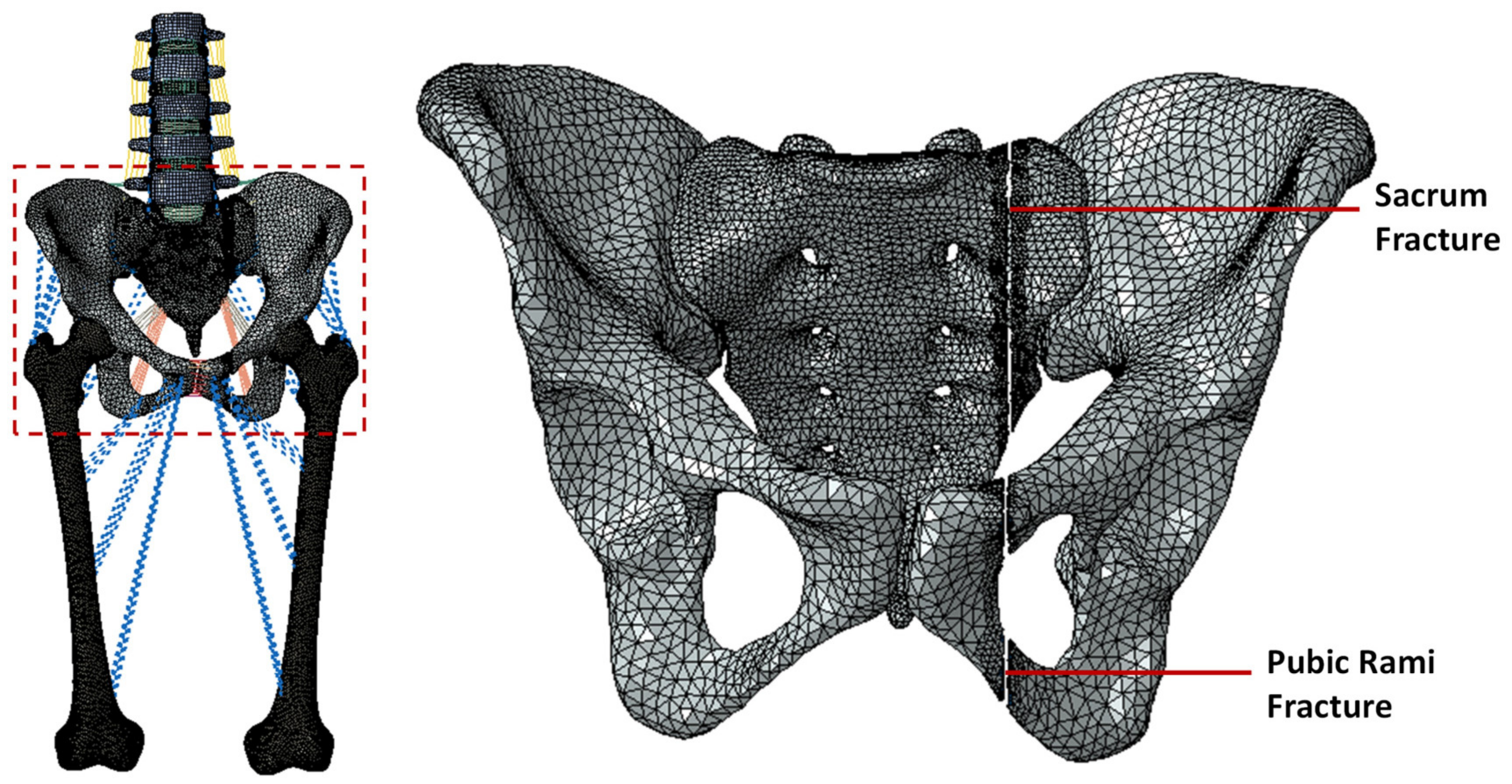
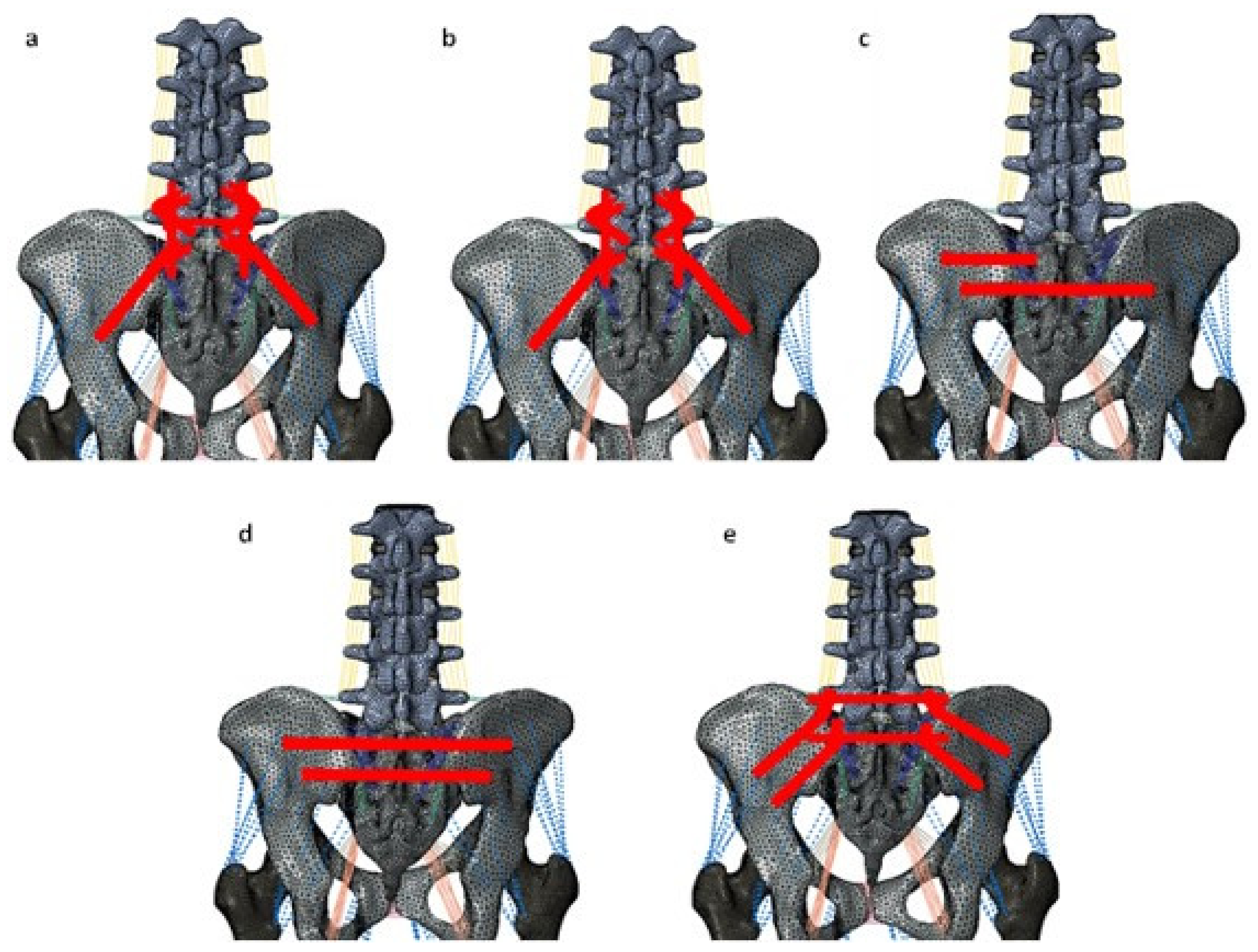
| Component | Material Properties | Constitute Relation | Element Type |
|---|---|---|---|
| Vertebral Cortical Bone (17,554 nodes and 9123 elements) | E = 12,000 MPa | Isotropic, Elastic | 8 Node Brick Element (C3D8) |
| v = 0.3 | |||
| Vertebral Cancellous Bone (41,357 nodes and 202,515 elements) | E = 100 MPa | Isotropic, Elastic | 4 Node Tetrahedral Element (C3D4) |
| v = 0.2 | |||
| Pelvis Cortical Bone (Sacrum, Ilium) (26,490 nodes and 26,762 elements) | E = 17,000 MPa | Isotropic, Elastic | 4 Node Tetrahedral Element (C3D4) |
| v = 0.3 | |||
| Sacrum Cancellous Bone (16,891 nodes and 70,679 elements) | Heterogenous | Isotropic, Elastic | 4 Node Tetrahedral Element (C3D4) |
| Ilium Cancellous Bone (20,083 nodes and 96,912 elements) | E = 70 MPa | Isotropic, Elastic | |
| v = 0.2 | 4 Node Tetrahedral Element (C3D4) | ||
| Femur Cortical Bone (31,776 nodes and 31,776 elements) | E = 17,000 MPa | Isotropic, Elastic | 4 Node Tetrahedral Element (C3D4) |
| v = 0.29 | |||
| Femur Cancellous Bone (64,486 nodes and 334,529 elements) | E = 100 MPa | Isotropic, Elastic | 4 Node Tetrahedral Element (C3D4) |
| v = 0.2 | |||
| Ground Substance of Annulus Fibrosis (24,320 nodes and 18,480 elements) | c10 = 0.035 | ||
| k1 = 0.296 | Hyper elastic anisotropic (HGO) | 8 Node Brick Element (C3D8) | |
| k2 = 65 | |||
| Nucleus Pulposus (14,326 nodes and 11,088 elements) | E = 1 MPa | Isotropic, Elastic | 8 Node Brick Element (C3D8) |
| v = 0.499 | |||
| Anterior Longitudinal (636 nodes and 553 elements) | 7.8 MPa (<12%), 20 MPa (>12%) | Non-linear Hypo elastic | Truss Element (T3D2) |
| Posterior Longitudinal (636 nodes and 553 elements) | 10 MPa (<11%), 20 MPa (>11%) | Non-linear Hypo elastic | Truss Element (T3D2) |
| Ligamentum Flavum (48 nodes and 24 elements) | 15 MPa (<6.2%), 19.5 MPa (>6.2%) | Non-linear Hypo elastic | Truss Element (T3D2) |
| Intertransverse (66 nodes and 33 elements) | 10 MPa (<18%), 58.7 MPa (>18%) | Non-linear Hypo elastic | Truss Element (T3D2) |
| Interspinous (60 nodes and 30 elements) | 10 MPa (<14%), 11.6 MPa (>14%) | Non-linear Hypo elastic | Truss Element (T3D2) |
| Supraspinous (45 nodes and 23 elements) | 8 MPa (<20%), 15 MPa (>20%) | Non-linear Hypo elastic | Truss Element (T3D2) |
| Capsular (45 nodes and 23 elements) | 7.5 MPa (<25%), 32.9 MPa (>25%) | Non-linear Hypo elastic | Truss Element (T3D2) |
| Anterior SIJ (52 nodes and 26 elements) | 125 MPa (5%), 325 MPa (>10%), 316 MPa (>15%) | Non-linear Hypo elastic | Truss Element (T3D2) |
| Short Posterior SI (20 nodes and 10 elements) | 43 MPa (5%), 113 MPa (>10%), 110 MPa (>15%) | Non-linear Hypo elastic | Truss Element (T3D2) |
| Long Posterior SI (32 nodes and 16 elements) | 150 MPa (5%), 391 MPa (>10%), 381 MPa (>15%) | Non-linear Hypo elastic | Truss Element (T3D2) |
| Interosseous (45 nodes and 23 elements) | 40 MPa (5%), 105 MPa (>10%), 102 MPa (>15%) | Non-linear Hypo elastic | Truss Element (T3D2) |
| Sacrospinous (32 nodes and 16 elements) | 304 MPa (5%), 792 MPa (>10%), 771 MPa (>15%) | Non-linear Hypo elastic | Truss Element (T3D2) |
| Sacrotuberous Ligament (58 nodes and 29 elements) | 326 MPa (5%), 848 MPa (>10%), 826 MPa (>15%) | Non-linear Hypo elastic | Truss Element (T3D2) |
| Gluteus Maximus | k = 344 N/mm | Connector Element | |
| Gluteus Medius | k = 779 N/mm | Connector Element | |
| Gluteus Minimus | k = 660 N/mm | Connector Element | |
| Psoas Major | k = 100 N/mm | Connector Element | |
| Adductor Magnus | k = 257 N/mm | Connector Element | |
| Adductor Longus | k = 134 N/mm | Connector Element | |
| Adductor Brevis | k = 499 N/mm | Connector Element | |
| Rods (Titanium) | E = 120,000 MPa | Isotropic, Elastic | Hexahedral Element |
| v = 0.3 | |||
| Pedicle Screws (Titanium) | E = 120,000 MPa | Isotropic, Elastic | Hexahedral Element |
| v = 0.3 |
Disclaimer/Publisher’s Note: The statements, opinions and data contained in all publications are solely those of the individual author(s) and contributor(s) and not of MDPI and/or the editor(s). MDPI and/or the editor(s) disclaim responsibility for any injury to people or property resulting from any ideas, methods, instructions or products referred to in the content. |
© 2024 by the authors. Licensee MDPI, Basel, Switzerland. This article is an open access article distributed under the terms and conditions of the Creative Commons Attribution (CC BY) license (https://creativecommons.org/licenses/by/4.0/).
Share and Cite
Tripathi, S.; Nishida, N.; Soehnlen, S.; Kelkar, A.; Kumaran, Y.; Seki, T.; Sakai, T.; Goel, V.K. Pelvic Ring Fractures: A Biomechanical Comparison of Sacral and Lumbopelvic Fixation Techniques. Bioengineering 2024, 11, 348. https://doi.org/10.3390/bioengineering11040348
Tripathi S, Nishida N, Soehnlen S, Kelkar A, Kumaran Y, Seki T, Sakai T, Goel VK. Pelvic Ring Fractures: A Biomechanical Comparison of Sacral and Lumbopelvic Fixation Techniques. Bioengineering. 2024; 11(4):348. https://doi.org/10.3390/bioengineering11040348
Chicago/Turabian StyleTripathi, Sudharshan, Norihiro Nishida, Sophia Soehnlen, Amey Kelkar, Yogesh Kumaran, Toshihiro Seki, Takashi Sakai, and Vijay K. Goel. 2024. "Pelvic Ring Fractures: A Biomechanical Comparison of Sacral and Lumbopelvic Fixation Techniques" Bioengineering 11, no. 4: 348. https://doi.org/10.3390/bioengineering11040348
APA StyleTripathi, S., Nishida, N., Soehnlen, S., Kelkar, A., Kumaran, Y., Seki, T., Sakai, T., & Goel, V. K. (2024). Pelvic Ring Fractures: A Biomechanical Comparison of Sacral and Lumbopelvic Fixation Techniques. Bioengineering, 11(4), 348. https://doi.org/10.3390/bioengineering11040348






